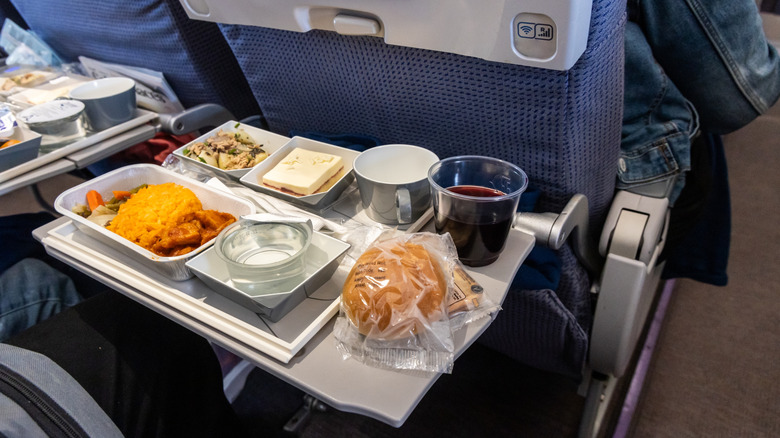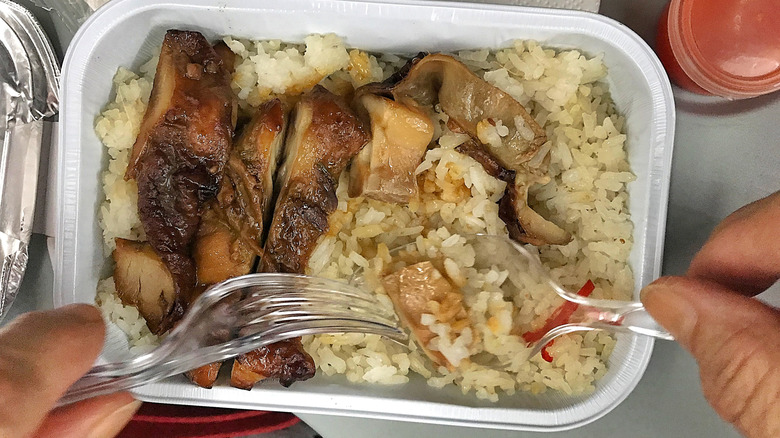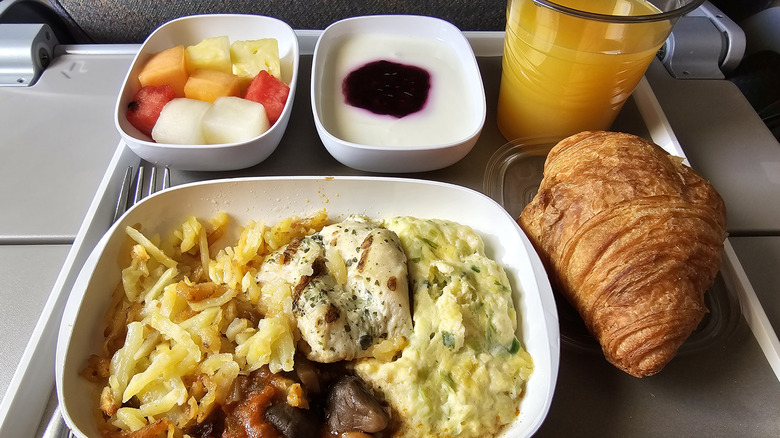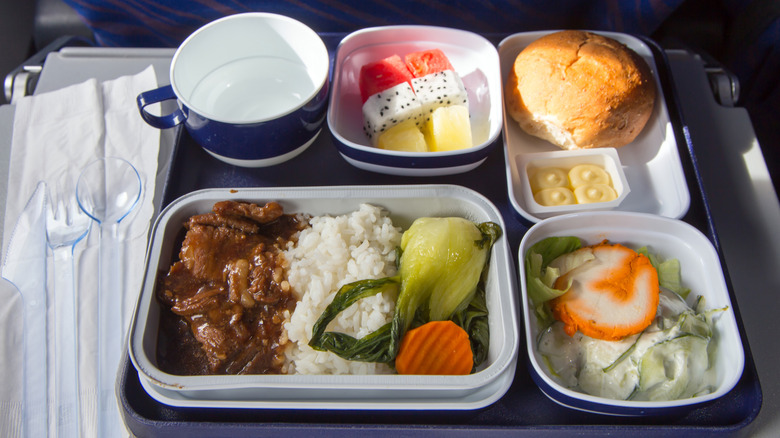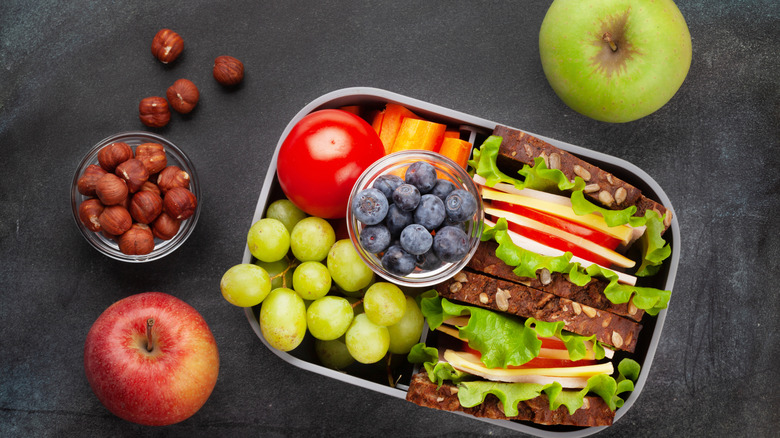The Foods You Should Avoid Ordering On An Airplane
At its best, airplane food is known to be... edible. Sure, in upgraded classes, a better meal might be included with the pricey ticket. But for the rest of us in Economy, the complementary meals are nothing to look forward to. Despite knowing we'll be disappointed by whatever comes out of the attendant's trolley, food is food, and it's nice to eat something on a long-haul flight. If you do decide to commit to a meal provided by the airline, know that there are some items you should avoid.
We're not trying to be food snobs here are Chowhound; these recommendations on what to avoid are solely based on food safety concerns. Stomach aches, food poisoning, and even foodborne illness are valid concerns when dining on airplanes. If you've ever felt unwell after eating on a flight, the food served could have been the culprit. Catering companies that supply airlines make millions of meals per year, but with all of the prepping, transporting, storing, and reheating, there is a lot of opportunity for food safety standards to accidentally go out the window.
In 2024, a Delta Airlines flight heading to Amsterdam from Detroit was forced to make an emergency landing in New York. The reason? Passengers had eaten moldy chicken which caused them to become ill in flight. In another incident from 2024, travelers flying from Guam to Tokyo experienced severe food poisoning, with some vomiting and others needing to be hospitalized after landing.
Skip the meat and seafood
Avoiding meat and seafood eliminates many potential meals that you would be served on an airplane, as many airlines offer shrimp scampi, beef stroganoff, grilled chicken, and plenty more. Temperature is the key reason why these categories are recommended to be avoided. Airplane food is prepared in a facility on the ground, and then transported to the plane. It can be difficult to manage correct temperatures during this process. Both meat and seafood require strict adherence to correct storage and reheating temperatures to prevent the growth of harmful bacteria.
If not stored or reheated correctly, bacteria can proliferate and cause you to become ill. Meat and seafood that has been undercooked is at risk of containing E. coli, and this is true for deli meats as well. Things like turkey and ham slices are made ready-to-eat and not reheated to a high temperature before serving, so if they haven't been refrigerated properly, E. coli is a possibility. Be cautious with that ham and cheese sandwich that doesn't seem like it could cause harm.
Be wary of dairy and eggs
Most airlines will offer a meat-based or vegetarian option when handing out in-flight meals. This doesn't require a special request, but there is almost always naturally an item like pasta or a scrambled egg breakfast sandwich. Therefore, dairy and eggs are two tricky ingredients to avoid on a flight, but there are some rules to keep in mind.
Undercooked eggs can also be a source of E. coli, so examine whatever dish you have, whether it features scrambled, hard-boiled, or omelet-style eggs, to ensure it has been cooked thoroughly. If anything appears runny, it's best to avoid eating it.
As for dairy, items like yogurt, milk, and soft cheeses can go bad rather quickly if not kept refrigerated. For example, bacteria will begin to grow in milk and yogurt after 2 hours at room temperature. Again, E. coli is a risk here, but other bacteria that also cause food poisoning like listeria and salmonella can also grow. Is the yogurt or cheese warm, when it should be cold? Don't risk it.
Take a rain check on raw vegetables and pre-cut fruits
A fresh salad or a bowl of fruit seems like a hydrating and refreshing option after breathing in recycled air for hours. However, raw veggies and pre-cut fruit are susceptible to the typical food poisoning bacteria culprits of E. coli, Salmonella, and Listeria. These bacteria are found in the soil where the produce is grown and can remain on the exterior of lettuce, vegetables, and fruit. If not washed, chopped, and stored properly, these can put you at risk for food poisoning and other illnesses.
It's not just on airlines either. These foods are responsible for a large amount of foodborne illness cases in the United States. With items like salad, chopped raw vegetables, or fruit slices, it's pretty much impossible to tell if it's safe to eat or not. Really, it's based on the level of risk management you're comfortable with taking. Vegetables that are cooked and served steaming hot are a safer bet than raw. Fruits that are served whole and unpeeled — like bananas, apples, and oranges — are the better choice over pre-cut fruit salads.
What food can you eat on airplanes?
In general, it's best to stick to hot vegetarian or vegan meals. Airlines allow you to select these options if you have any dietary restrictions. This can be done online or over the phone. With this choice, you'll be eliminating potentially contaminated meat and seafood, and for vegetarian dishes, just keep an eye out for potentially sketchy dairy, egg, and raw items.
The packaged snack foods passed out by airlines are definitely safe to eat, as are any bread products. Remember that whole, unpeeled fruits and cooked vegetables are good choices. Canned and bottled drinks are perfectly fine, but there are mixed opinions when it comes airplane coffee, ice, and hot water. Sometimes the water tanks and ice storage are not cleaned as often as they should be. Alcohol is also okay to drink, but it could further dehydrate you. Plus, you should skip the expensive wine, as it's not worth it. As for meals, hot dishes like stews, soups, curries, and cooked vegetables are going to be the safest bet.
When it comes down to it, trust your gut instinct. If a food looks or tastes off, it probably is. The safest way to eat food on an airplane is to bring your own. You know exactly how it was prepared and stored, so there's no guesswork involved here. Check what the TSA allows in terms of liquid, but there are plenty of foods and snacks that will make it through security.
